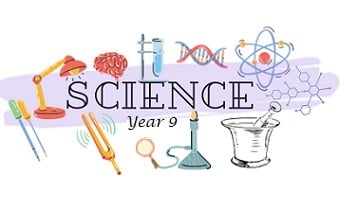Science for Year 9
School Education divided into 13 grade levels. Each grade level has certain standards for different skills. Teacher’s job is to detect students’ real year level and her/his needs to continue her/his academic development.
A comprehensive set of progressive learning objectives for science year 9. The objectives detail what the learner should know or what they should be able to do in science in year 9 of primary education.
E Scientific enquiry
Ep Ideas and evidence
• 9Ep1 Discuss and explain the importance of questions, evidence and explanations, using historical and contemporary examples.
• 9Ep2 Test explanations by using them to make predictions and then evaluate these against evidence.
• 9Ep3 Discuss the way that scientists work today and how they worked in the past, including reference to experimentation, evidence and creative thought.
Ep Plan investigative work
• 9Ep4 Select ideas and produce plans for testing based on previous knowledge, understanding and research.
• 9Ep5 Suggest and use preliminary work to decide how to carry out an investigation.
• 9Ep6 Decide whether to use evidence from first hand experience or secondary sources.
• 9Ep7 Decide which measurements and observations are necessary and what equipment to use.
• 9Ep8 Decide which apparatus to use and assess any hazards in the laboratory, field or workplace.
• 9Ep9 Use appropriate sampling techniques where required.
Eo Obtain and present evidence
• 9Eo1 Make sufficient observations and measurements to reduce error and make results more reliable.
• 9Eo2 Use a range of materials and equipment and control risks.
• 9Eo3 Make observations and measurements.
• 9Eo4 Choose the best way to present results.
Ec Consider evidence and approach
• 9Ec1 Describe patterns (correlations) seen in results.
• 9Ec2 Interpret results using scientific knowledge and understanding.
• 9Ec3 Look critically at sources of secondary data.
• 9Ec4 Draw conclusions.
• 9Ec5 Evaluate the methods used and refine for further investigations.
• 9Ec6 Compare results and methods used by others.
• 9Ec7 Present conclusions and evaluation of working methods in different ways.
• 9Ec8 Explain results using scientific knowledge and understanding. Communicate this clearly to others.
B Biology
Bp Plants
• 9Bp1 Define and describe photosynthesis, and use the word equation.
• 9Bp2 Understand the importance of water and mineral salts to plant growth.
• 9Bp3 Understand sexual reproduction in flowering plants, including pollination, fertilisation, seed formation and dispersal.
Be Living things in their environment
• 9Be1 Explain the ways in which living things are adapted to their habitats. Secondary sources can be used.
• 9Be2 Research the work of scientists studying the natural world. Secondary sources can be used.
• 9Be3 Explain and model food chains, food webs and energy flow.
• 9Be4 Explain the role of decomposers.
• 9Be5 Describe factors affecting the size of populations.
• 9Be6 Describe and investigate some effects of human influences on the environment.
Bv Variation and classification
• 9Bv1 Use and construct keys to identify plants and animals.
• 9Bv2 Understand that organisms inherit characteristics from their parents through genetic material that is carried in cell nuclei.
• 9Bv3 Describe how selective breeding can lead to new varieties.
• 9Bv4 Discuss the work of Darwin in developing the scientific theory of natural selection.
C Chemistry
Cp Material properties
• 9Cp1 Describe the structure of an atom and learn about the methods and discoveries of Rutherford.
• 9Cp2 Compare the structures of the first twenty elements of the Periodic Table.
• 9Cp3 Describe trends in groups and periods.
• 9Cp4 Talk about the contribution of scientists. Secondary sources can be used.
Cc Material changes
• 9Cc1 Explore and explain the idea of endothermic processes, e.g. melting of ice, and exothermic reactions, e.g. burning, oxidation.
• 9Cc2 Describe the reactivity of metals with oxygen, water and dilute acids.
• 9Cc3 Explore and understand the reactivity series.
• 9Cc4 Give examples of displacement reactions.
• 9Cc5 Explain how to prepare some common salts by the reactions of metals and metal carbonates and be able to write word equations for these reactions.
• 9Cc6 Give an explanation of the effects of concentration, particle size, temperature and catalysts on the rate of a reaction.
P Physics
Pf Forces and motion
• 9Pf1 Explain that pressure is caused by the action of a force on an area.
• 9Pf2 Determine densities of solids, liquids and gases.
• 9Pf3 Explain pressures in gases and liquids (qualitative only).
• 9Pf4 Know that forces can cause objects to turn on a pivot and understand the principle of moments.
Pm Electricity
• 9Pm1 Describe electrostatics and the concept of charge, including digital sensors.
• 9Pm2 Interpret and draw simple parallel circuits.
• 9Pm3 Model and explain how common types of components, including cells (batteries), affect current.
• 9Pm4 Explain how current divides in parallel circuits.
• 9Pm5 Measure current using ammeters and voltage using voltmeters, including digital meters.
Pe Energy
• 9Pe1 Use knowledge of energy sources including fossil fuels and renewable energy resources to consider the world’s energy needs, including research from secondary sources.
• 9Pe2 Identify and explain the thermal (heat) energy transfer processes of conduction, convection and radiation.
• 9Pe3 Explain cooling by evaporation.





Reviews
There are no reviews yet.